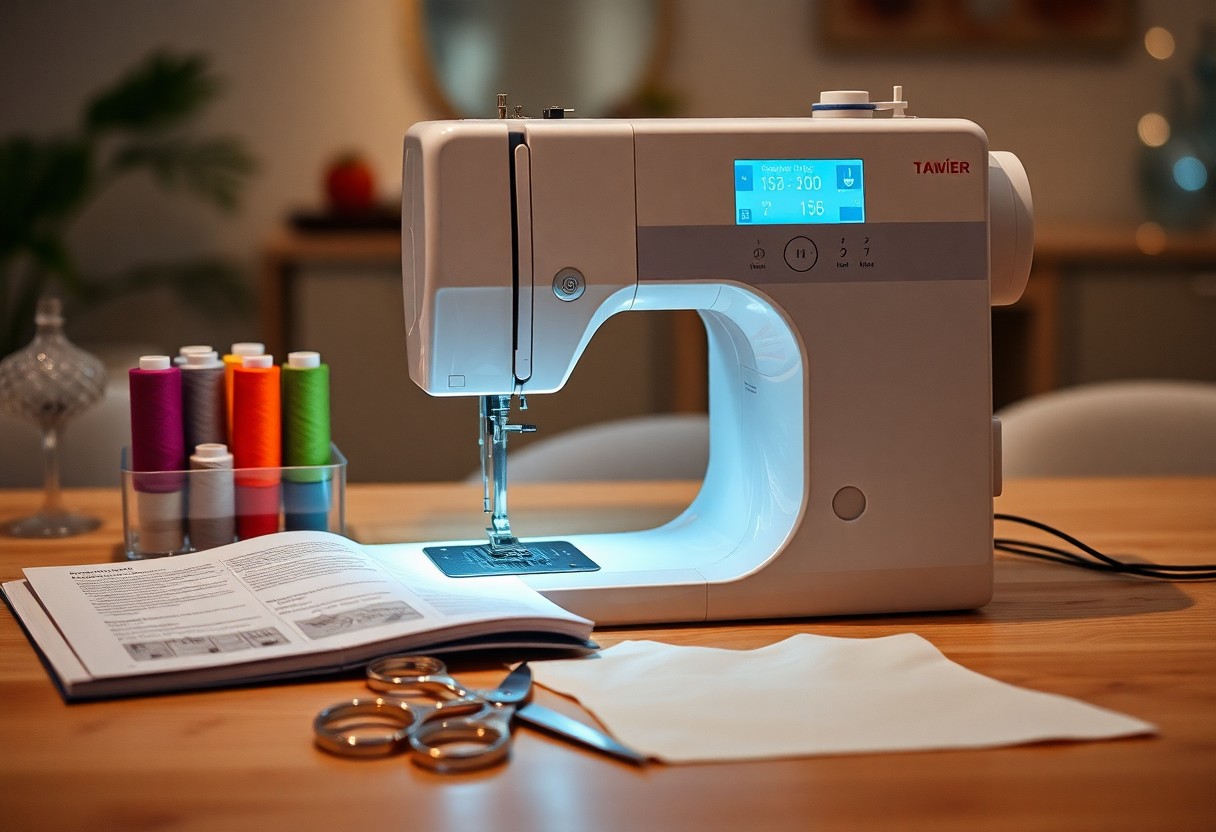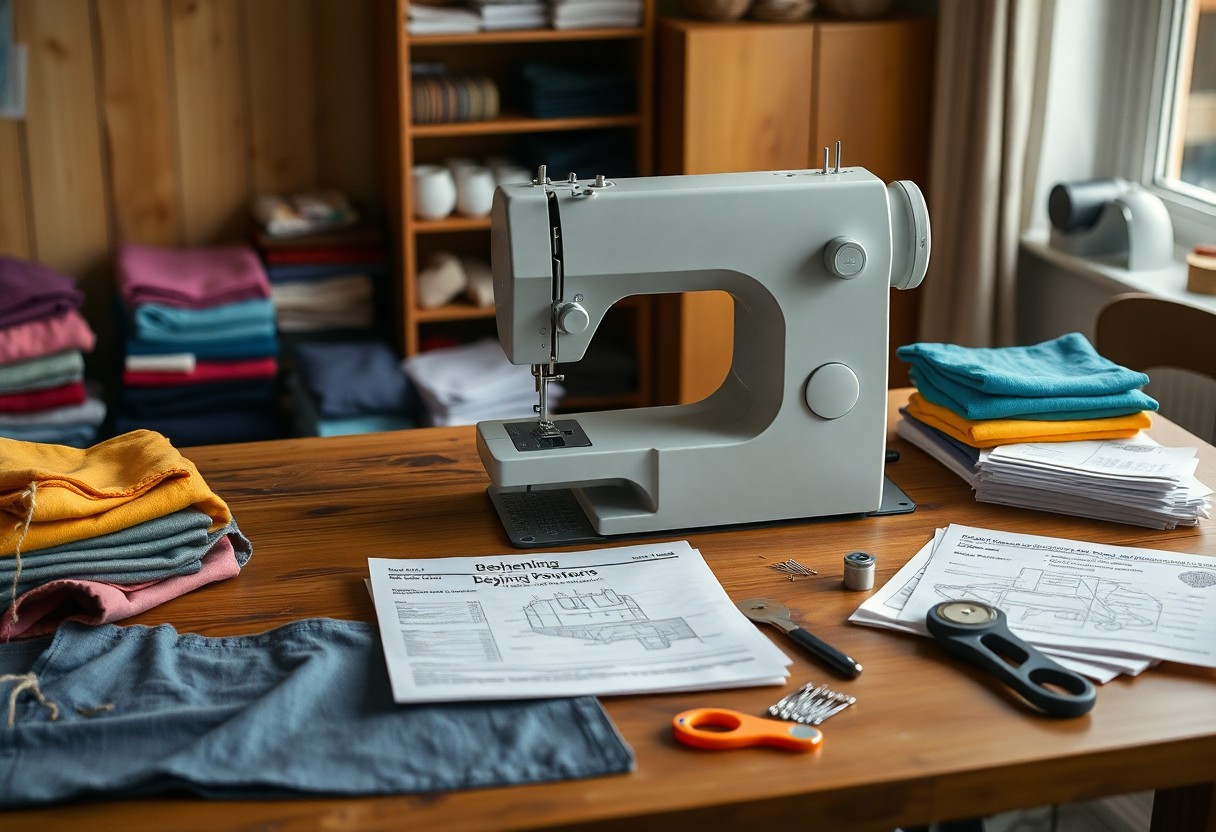Setting the Stage for Your Sewing Journey
Designing Your Workspace
Transform a corner of your home into a dedicated sewing space. Ideally, choose an area with natural light and ample room for your machine and materials. Use a sturdy table that accommodates your sewing machine and allows for easy fabric manipulation. Add storage solutions, such as bins and shelves, to keep your tools and fabrics organized. Consider investing in a comfortable chair since you’ll be spending hours here; ergonomics are key to maintaining focus and avoiding fatigue during long sewing sessions.
Gathering Essential Tools
Stock up on vital tools to enhance your sewing experience. A good pair of fabric scissors, seam ripper, measuring tape, and pins are non-negotiables. Consider adding a rotary cutter and mat for clean, straight cuts. Quality thread will also make a significant difference; opt for polyester for durability. According to expert sewists, investing in reliable tools can save you hours of frustration and significantly improve the quality of your finished projects.
Choosing Your First Project
Selecting the right first project can set the tone for your sewing journey. Start with a simple design, like a pillowcase or a tote bag, to build your skills without overwhelming yourself. Patterns labeled as “easy” usually have fewer pieces and straightforward instructions. Completing your first project will boost your confidence, enabling you to tackle more complex designs as your skill set grows.
Choosing the Right Sewing Machine for You
The foundation of your sewing journey starts with selecting the ideal machine. Not all sewing machines are created equal, and understanding the different types available will help you make an informed decision. Whether you plan to tackle simple projects or more complex tasks, finding a machine tailored to your needs is vital for success.
Key Features to Look For
Focus on specific features that enhance your sewing experience. Look for machines with a variety of stitch options, needle positions, and automatic buttonhole capabilities. Additionally, consider adjustable presser foot pressure, thread tension controls, and built-in needle threaders. A strong and reliable motor power will ensure longevity and efficiency in your projects. Thou, these features will significantly impact your sewing enjoyment and ease.
- Stitch options
- Needle positions
- Automatic buttonhole capabilities
- Adjustable presser foot pressure
- Thread tension controls
- Built-in needle threaders
- Motor power
Budget Considerations
Your budget plays a key role in choosing your sewing machine. Machines can range from under $100 to several thousand dollars, depending on features and brand. Assess what you’re willing to spend while keeping in mind your sewing goals. A beginner might find a reliable machine in the $150 to $400 range, providing ample features without breaking the bank.
Prioritizing quality over brand name ensures you receive a solid value. Machines in the lower price range often lack vital features but investing in a mid-range model can enhance your sewing experience significantly. Look for sales or refurbished models to maximize your budget. Ultimately, purchasing a machine that suits your sewing ambitions prevents future upgrades, allowing you to focus on honing your skills and creating beautiful projects.
Essential Sewing Supplies: What You Really Need
Your sewing journey begins with gathering important supplies that will make the process smoother and more enjoyable. You’ll want a well-functioning sewing machine, which should include a zigzag stitch and adjustable settings. In addition to fabric, stock up on quality thread, scissors, pins, and measuring tools. An iron and an ironing board are also vital for ensuring neat seams and finishing touches. Once you have these basics, you’ll find it much easier to focus on honing your sewing skills.
Fabrics That Suit Beginners
Choosing the right fabric as a beginner is key to your success and enjoyment. Opt for cotton fabrics, which are forgiving, easy to work with, and widely available. They come in various prints and colors, making them perfect for starting projects like quilts or simple garments. Avoid slippery or stretchy materials such as chiffon or jersey until you gain more experience. Stick with medium-weight cottons to build your confidence as you learn the techniques of sewing.
Must-Have Tools and Accessories
Several tools and accessories will enhance your sewing experience and increase efficiency. A set of quality sewing scissors is important, as they help you make precise cuts without fraying fabric edges. Invest in a rotary cutter and mat for quicker fabric slicing, along with a good seam ripper for those inevitable mistakes. Additional items like tailor’s chalk, fabric clips, and a walking foot can also simplify various sewing tasks and improve accuracy.
The right tools can dramatically improve your sewing process. For instance, a seam gauge allows you to measure hems and seams with precision, and pins keep layers of fabric together while you sew, minimizing shifting. A reliable measuring tape ensures that your fabric pieces are cut accurately, leading to better-fitting garments. Additionally, having a variety of needles suited to different fabrics will help you avoid issues like skipped stitches or fabric snags, making your projects run seamlessly.

Mastering the Basics: First Steps to Sewing Success
To commence on your sewing journey, honing the fundamentals is imperative. Start by familiarizing yourself with the various components of your sewing machine, including the needle, bobbin, and threading system. Develop a solid understanding of different types of stitches and their applications, allowing you to select the right one for each project. Additionally, practice imperative techniques like fabric handling and seam finishing, setting a strong foundation for your sewing skills.
Learning to Set Up Your Machine
Setting up your sewing machine is the first step toward successful projects. Refer to the manual for specific instructions on threading, adjusting tension, and winding the bobbin. Familiarize yourself with the sewing machine’s features, such as stitch selection and foot attachments. Proper setup ensures your machine operates smoothly and effectively, minimizing frustration as you begin to sew.
Tackling Simple Projects
Starting with simple projects boosts your confidence and reinforces your skills. Basic items like pillowcases, tote bags, or simple skirts serve as excellent practice. Focus on evenly sewing straight lines while mastering seam allowances and finishing techniques. These projects encourage experimentation with fabrics and stitches, fostering a sense of achievement as you create functional items.
For instance, crafting a tote bag requires only a few straight seams and minimal fabric, making it a perfect starting point. Choose sturdy fabric, such as canvas, and incorporate simple techniques like top-stitching for added durability. Completing such a project not only showcases your progress but also equips you with skills applicable to more complex creations down the line.
Navigating Common Beginner Pitfalls
As you begin on your sewing journey, avoiding common pitfalls can significantly enhance your experience and outcomes. Many beginners underestimate the importance of understanding their sewing machine and the fabric they work with, leading to frustration and mistakes. Developing patience and honing your skills gradually will help you build confidence and achieve better results. Taking the time to educate yourself on basic techniques and best practices ensures that your early sewing projects are enjoyable and successful, setting a solid foundation for future creations.
Three Critical Mistakes Most Beginners Make
Many beginners rush into sewing without familiarizing themselves with their machine, leading to missed features and functions. Overlooking the importance of pre-washing fabrics can cause shrinkage and distortions later on. Additionally, starting with overly ambitious projects can result in discouragement when simpler pieces might offer a more attainable challenge. By focusing on understanding your tools, preparing your materials correctly, and selecting appropriate projects, you can avoid these missteps and enhance your sewing experience.
How to Troubleshoot Common Issues
Common sewing issues often stem from tension problems, unthreaded bobbins, or misaligned fabric. If your stitches appear uneven or skip altogether, adjusting the tension dial is a straightforward fix. Ensure your bobbin is wound correctly and threaded properly to prevent sewing errors. Misalignment can typically be corrected by guiding your fabric gently while sewing, maintaining an even pace and pressure. Always consult your machine’s manual for specific troubleshooting steps tailored to your model.
For more detailed troubleshooting, take time to learn about your machine’s specific quirks. If you experience thread bunching, check for debris in the threading path or in the bobbin area that might impede smooth operation. Keeping a sewing journal can help track recurring issues, allowing you to identify patterns and resolve them more effectively. Connecting with sewing communities, whether online or in-person, can also provide you with tips and collective wisdom from other beginners and experienced sewists alike.

Expanding Your Skills: Next Steps After Your First Projects
Once you’ve mastered a few simple projects, it’s time to expand your sewing skills. Challenge yourself with more complex patterns and explore various types of fabric to enhance your technique. Consider joining a local sewing group or online community to share experiences, gain tips, and receive feedback. Engaging with fellow sewists will not only build your confidence but also introduce you to new styles and methods, paving the way for more ambitious creations.
Exploring Different Techniques
Dive into a world of sewing techniques that can elevate your projects. From quilt-making to garment construction, each technique offers unique challenges and rewards. Experiment with appliqué and embellishments to add character to your work. Online tutorials and workshops can provide step-by-step guidance, making it easy to try new methods and discover what you enjoy most.
Finding Your Creative Style
Identifying your creative style is a personal journey that enhances your sewing experience. You might find inspiration in various sources, such as fashion magazines, nature, or even art. Keep a mood board or a digital collection of projects you admire, noting what attracts you. This process will help you curate designs that reflect your uniqueness and evolve your sewing practice.
Your creative style can emerge through color combinations, fabric choices, or the types of projects you gravitate towards. Pay attention to your preferences as you progress; do you favor bold prints or minimalist designs? Are you drawn to modern silhouettes or vintage aesthetics? Engaging with the broader sewing community can offer fresh perspectives and inspiration, allowing your creativity to flourish. Ultimately, finding your style is about experimentation and enjoyment, so allow yourself the freedom to play and discover what resonates with you.
Final Words
From above, you have explored the crucial steps to jumpstart your sewing journey in 2025. By understanding the key features of sewing machines, selecting the right fabric, and practicing basic techniques, you can confidently begin on your creative sewing projects. Embrace the learning process, and don’t hesitate to seek out resources or communities for support. With patience and persistence, your skills will develop, allowing you to create beautiful garments and projects that reflect your unique style.
FAQ
Q: What equipment do I need to start sewing as a beginner in 2025?
A: To start sewing, you will need a sewing machine, fabric, thread, scissors, pins, and a measuring tape. Additionally, having a seam ripper and a basic sewing kit can be helpful for fixing mistakes and carrying out small repairs.
Q: Are there specific types of sewing machines recommended for beginners?
A: Yes, beginners should look for sewing machines that are user-friendly, lightweight, and have automatic features. Brands like Brother and Singer offer models with easy-to-follow instructions and fewer advanced settings, making them ideal for those just starting.
Q: What simple projects can a beginner start with to practice sewing skills?
A: Beginners can start with simple projects like pillowcases, tote bags, or simple skirts. These projects typically require basic sewing techniques, helping to build confidence and improve skills while using minimal materials.
